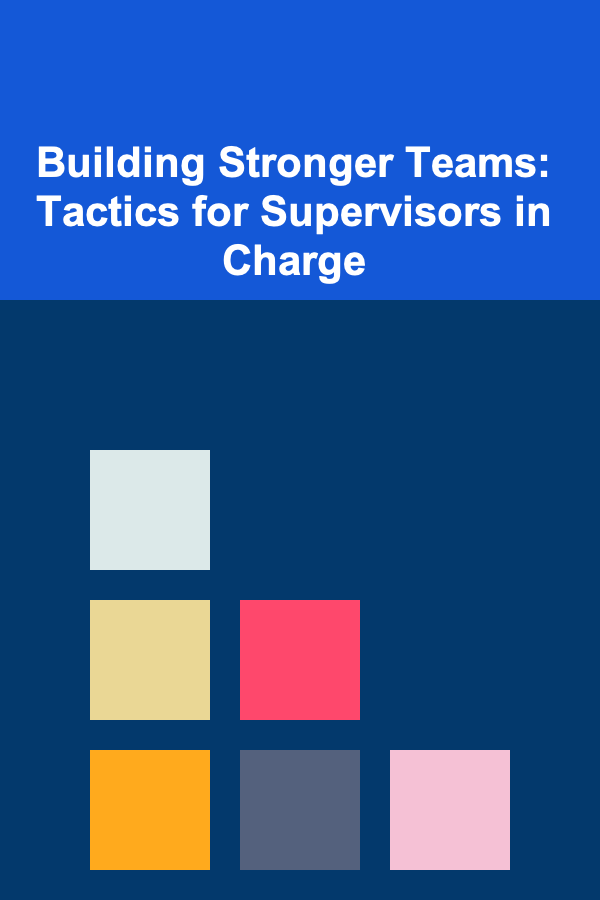
Building Stronger Teams: Tactics for Supervisors in Charge
ebook include PDF & Audio bundle (Micro Guide)
$12.99$6.99
Limited Time Offer! Order within the next:

Effective teams are the backbone of any successful organization. As a supervisor, one of your primary responsibilities is to cultivate a high-performing team that collaborates efficiently, overcomes challenges, and drives results. The strength of your team will directly impact the performance of the organization. Building stronger teams is not just about filling seats or assigning tasks; it's about creating a culture of trust, respect, and mutual support, where each member feels valued and empowered.
In this actionable guide, we will explore the key tactics and strategies that supervisors can adopt to build stronger, more cohesive teams. These methods are designed to enhance communication, foster collaboration, resolve conflicts, and inspire continuous growth.
Set Clear Expectations and Goals
One of the first steps in building a strong team is establishing clarity around goals, roles, and expectations. When team members understand what is expected of them and how their work aligns with the broader goals of the organization, they are more likely to perform effectively and feel a sense of purpose.
Key Actions:
- Define Team Goals: Start by setting clear, measurable, and achievable goals for the team. Whether it's achieving sales targets, launching a product, or improving customer service, your goals should align with the overall mission of the company.
- Clarify Roles and Responsibilities: Ensure that each team member understands their individual responsibilities. This minimizes overlap and confusion, while also fostering accountability.
- Make Goals SMART: Adopt the SMART framework---Specific, Measurable, Achievable, Relevant, and Time-bound---to ensure that goals are practical and actionable.
Tools to Use:
- OKRs (Objectives and Key Results): OKRs provide a framework for setting and tracking measurable goals at both the team and individual levels.
- Performance Reviews: Regularly assess team members' progress toward goals and provide constructive feedback.
Foster Open Communication
Effective communication is the cornerstone of any successful team. Without clear communication, misunderstandings can arise, productivity can falter, and team dynamics can suffer. As a supervisor, it's essential to facilitate open lines of communication at all levels.
Key Actions:
- Create an Open-Door Policy: Encourage team members to voice their opinions, concerns, and ideas without fear of judgment. Let them know they can approach you at any time.
- Regular Check-ins: Hold regular one-on-one meetings with team members to understand their challenges, goals, and development needs. Additionally, conduct team meetings to ensure everyone is on the same page.
- Encourage Feedback: Actively ask for and listen to feedback from your team. Constructive criticism should be welcomed, and employees should feel their voices are heard and valued.
- Use Technology to Stay Connected: For teams that are remote or hybrid, tools like Slack, Zoom, or Microsoft Teams help maintain consistent communication.
Tools to Use:
- Feedback Surveys: Use tools like SurveyMonkey to gather anonymous feedback from team members on communication practices and overall team dynamics.
- Project Management Tools: Software such as Asana or Trello helps organize tasks and keep communication flowing smoothly, particularly in complex projects.
Promote Collaboration and Teamwork
Teamwork is at the heart of any high-performing group. To build a stronger team, supervisors must actively encourage collaboration, ensuring that team members share knowledge, skills, and expertise to achieve common goals.
Key Actions:
- Foster a Collaborative Environment: Create an atmosphere where team members feel comfortable sharing ideas and collaborating on projects. Encourage brainstorming sessions and teamwork-focused activities.
- Cross-Training: Promote cross-training to ensure that team members can support one another, even in areas outside their immediate responsibilities. This improves overall team flexibility and knowledge-sharing.
- Team-Building Activities: Organize team-building exercises that focus on cooperation, problem-solving, and trust-building. These can be both in-person and virtual, depending on your team's setup.
Tools to Use:
- Collaborative Platforms: Tools like Google Docs or Miro can facilitate real-time collaboration on documents and projects, allowing teams to work together more efficiently.
- Team-Building Workshops: Invest in workshops or retreats that focus on developing teamwork skills, improving conflict resolution, and boosting morale.
Encourage Continuous Learning and Development
To build a stronger team, you must ensure that your team members are continually growing in their skills and knowledge. This is not only beneficial for individual development but also strengthens the entire team by equipping it with the latest tools and strategies.
Key Actions:
- Provide Opportunities for Skill Development: Offer your team access to training programs, workshops, online courses, and certifications relevant to their roles.
- Encourage Knowledge Sharing: Create opportunities for team members to share what they've learned from external courses or on-the-job experiences. This can be done through regular knowledge-sharing sessions or internal seminars.
- Promote a Growth Mindset: Encourage team members to see challenges as opportunities to learn and grow. By fostering a growth mindset, you help them approach obstacles with a positive, solution-focused attitude.
Tools to Use:
- Learning Management Systems (LMS): Use platforms like Coursera or LinkedIn Learning to provide employees with access to relevant courses and certifications.
- Internal Knowledge Base: Tools like Confluence or Notion can be used to store shared knowledge and best practices within the team.
Resolve Conflicts Constructively
In any team, conflict is inevitable. It's not the conflict itself that matters but how it is addressed. Supervisors must be prepared to mediate and resolve conflicts in a way that maintains team cohesion and productivity.
Key Actions:
- Address Issues Early: Don't wait for a small issue to turn into a major conflict. If a problem arises, address it as soon as possible before it escalates.
- Be Neutral and Objective: When resolving conflicts, be impartial and fair. Listen to all sides of the story and encourage team members to express their perspectives calmly and respectfully.
- Encourage Open Dialogue: Foster an environment where team members feel comfortable discussing their issues in a respectful and solution-focused manner.
- Set Ground Rules: Establish clear expectations for how conflicts should be handled within the team. Encourage a culture of respect, active listening, and constructive feedback.
Tools to Use:
- Conflict Resolution Frameworks: Familiarize yourself with frameworks such as the Thomas-Kilmann Conflict Mode Instrument (TKI) to better understand and manage different conflict styles.
- Mediation Techniques: Consider taking mediation courses or workshops to better manage interpersonal conflicts within your team.
Recognize and Reward Achievements
Recognition plays a crucial role in motivating employees and building a strong team. When people feel their contributions are acknowledged, they are more likely to stay engaged and committed to the team's success.
Key Actions:
- Celebrate Successes: Regularly acknowledge both small wins and significant achievements. Whether it's through public recognition in meetings or a personal note, make sure team members feel valued.
- Create Incentives: Implement reward systems to incentivize performance, such as employee of the month, bonuses, or special perks.
- Encourage Peer Recognition: Allow team members to recognize each other's contributions. Peer recognition fosters a sense of community and reinforces positive behaviors.
Tools to Use:
- Employee Recognition Platforms: Tools like Bonusly or Kudos can be used to facilitate peer recognition and reward programs.
- Team Celebrations: Organize team lunches, virtual happy hours, or celebratory events to mark major milestones and achievements.
Provide Constructive Feedback
Constructive feedback is essential for continuous improvement and team development. As a supervisor, providing timely, specific, and actionable feedback helps team members refine their skills and avoid potential mistakes in the future.
Key Actions:
- Focus on Behavior, Not Personality: When giving feedback, focus on the actions or behaviors that need improvement rather than personal characteristics.
- Be Specific and Actionable: Instead of vague comments, provide clear examples of what the team member did well and areas where improvement is needed. Offer specific suggestions on how to improve.
- Create a Two-Way Feedback Culture: Encourage your team to provide feedback on your management style as well. This fosters an environment of continuous improvement for both you and the team.
Tools to Use:
- 360-Degree Feedback: Use tools like SurveyMonkey or Officevibe to gather feedback from all levels, providing a holistic view of team performance and individual contributions.
- Regular Performance Reviews: Schedule regular performance reviews to provide in-depth feedback and discuss professional development plans.
Conclusion
Building stronger teams is an ongoing process that requires consistent effort, effective strategies, and a commitment to creating a supportive, collaborative, and growth-oriented environment. By setting clear expectations, fostering open communication, encouraging continuous learning, and addressing conflicts constructively, supervisors can cultivate teams that not only perform well but also thrive together.
Ultimately, strong teams are the result of strong leadership, mutual respect, and a shared commitment to success. As a supervisor, your role is to guide, support, and inspire your team to reach their full potential. Through these tactics, you can transform your team into a high-performing, resilient, and cohesive unit capable of achieving both short-term objectives and long-term success.

How to Create a Morning Routine Checklist for a Productive Day
Read More
How to Maximize Closet Space with Simple Organization Hacks
Read More
How to Organize Your Closet by Color
Read More
How to Organize Your Essential Oils for Craft Projects
Read More
How to Sell Handmade Jewelry on Instagram: An Actionable Guide
Read More
How to Use a Lazy Susan for Pantry Organization
Read MoreOther Products

How to Create a Morning Routine Checklist for a Productive Day
Read More
How to Maximize Closet Space with Simple Organization Hacks
Read More
How to Organize Your Closet by Color
Read More
How to Organize Your Essential Oils for Craft Projects
Read More
How to Sell Handmade Jewelry on Instagram: An Actionable Guide
Read More